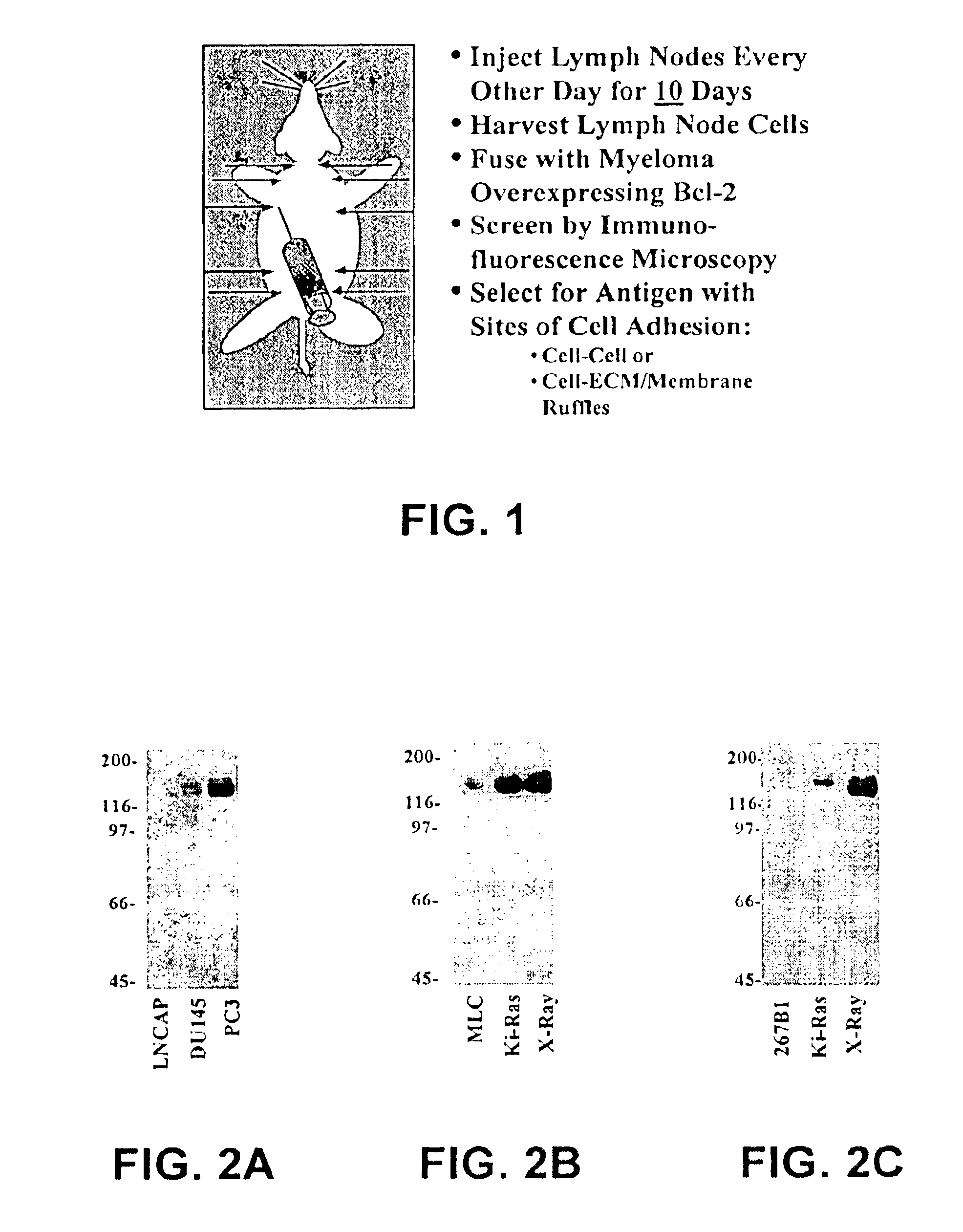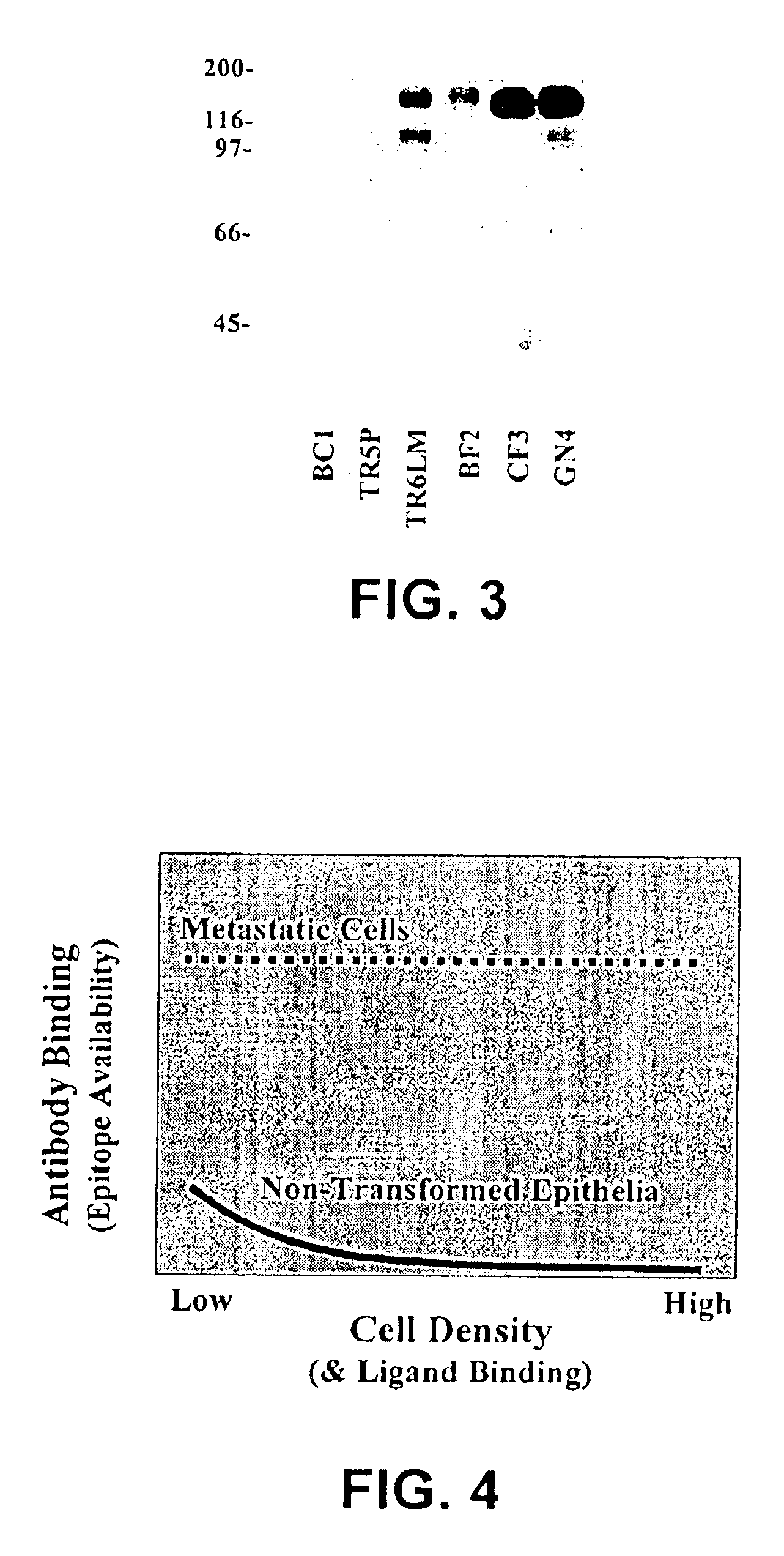Treatment of metastatic disease
a metastatic disease and metastatic technology, applied in the field of metastatic disease diagnosis and treatment, can solve the problems of malignant cells that metastasize, the most dangerous form of cancer, etc., and achieve the effects of promoting ecm adhesion, reducing tumor burden, and increasing expression of tyrosine kinases
- Summary
- Abstract
- Description
- Claims
- Application Information
AI Technical Summary
Benefits of technology
Problems solved by technology
Method used
Image
Examples
example 1
Characterization of EphA2 Expression in Metastatic Cells
[0036]Following the RIMMS strategy using tyrosine phosphorylated proteins from Ras-transformed human epithelial cells, hybridomas were screened, and an antibody specific for EphA2 has been isolated. This antibody, B2D6, was used to assess the levels of EphA2 expression in nontransformed prostatic epithelial cells and prostatic tumor cells. Low levels of EphA2 expression were found in non-transformed prostatic epithelial cells, but this EphA2 expression was enriched within sites of cell-cell contact and interacted with cell-bound ligand. Compared to non-transformed cells, two features distinguish EphA2 in metastatic prostate cancer cells: 1) EphA2 is overexpressed; 2) EphA2 is diffusely distributed and does not appear to interact with ligand. To confirm these data, western blots were performed using the EphA2 specific antibodies. EphA2 overexpression in human prostate cancer cells (LNCAP, DU145, PC3) directly correlates with the...
example 2
In Vitro Targeting of Metastatic Cells
[0039]EphA2 overexpression renders metastatic cells susceptible to antibody-mediated selected killing with the present antibodies specific for an extracellular epitope of EphA2. While normal cells express EphA2, it is believed that ligand binding or clustering within sites of cell-cell contact occludes extracellular epitopes in normal cells and renders them inaccessible to antibodies specific for an extracellular epitope of EphA2. The tumor selectivity of the antibodies of the present invention is believed to rival or exceed that of Herceptin® for targeting metastatic cancer.
[0040]EphA2 overexpression provides a basis for targeting metastatic cancer cells with EphA2-specific antibodies. Antibodies specific for an extracellular epitope of EphA2, such as those produced by hybridoma B2D6, may be used to alter selectively (versus normal cells) the proliferative or invasive behaviors of metastatic cancer cells. In both metastasis-derived and laborato...
example 3
In Vitro Antibody Mediated Cytotoxicity
[0044]Preliminary results demonstrate that EphA2 antibodies impede metastatic cell growth. To measure antibody-directed cytotoxicity, preferably, nonradioactive versions of 51Cr-release assays using target cells (normal or metastatic prostatic epithelial cells) labeled with europium chloride (EuCl3) and diethylenetriamine-pentaacetic acid (DTPA) are performed. After washing away unincorporated Eu3+, naphthoyltrifluoroacetone (NTA) and trioctylphosphine oxide are incubated with the cytolytic agents and assay supernatants. The luminescence of resultant ternary complex (Eu3+ / NTA / trioctylphosphine oxide) is measured using a fluorescence microplate reader. The sensitivity of this Eu3+-release assay for complement-mediated cytolysis has been reported to be fivefold better than 51Cr-release assays. To determine specific lysis, parallel samples are hyponically lysed by adding distilled water. Untreated samples and isotype matched antibodies serve as ne...
PUM
| Property | Measurement | Unit |
|---|---|---|
| median volume | aaaaa | aaaaa |
| volume | aaaaa | aaaaa |
| physical interactions | aaaaa | aaaaa |
Abstract
Description
Claims
Application Information
 Login to View More
Login to View More - R&D
- Intellectual Property
- Life Sciences
- Materials
- Tech Scout
- Unparalleled Data Quality
- Higher Quality Content
- 60% Fewer Hallucinations
Browse by: Latest US Patents, China's latest patents, Technical Efficacy Thesaurus, Application Domain, Technology Topic, Popular Technical Reports.
© 2025 PatSnap. All rights reserved.Legal|Privacy policy|Modern Slavery Act Transparency Statement|Sitemap|About US| Contact US: help@patsnap.com


